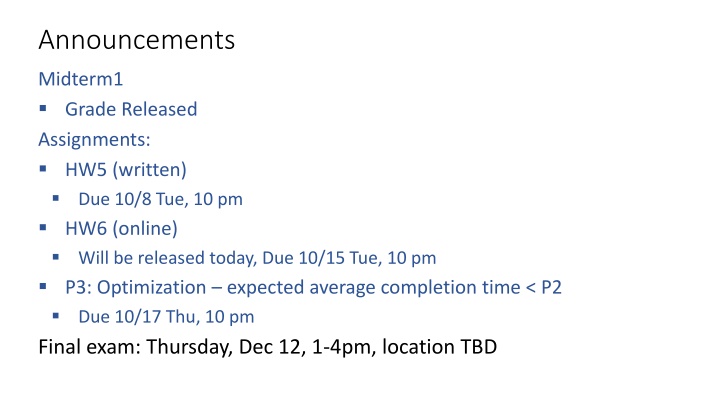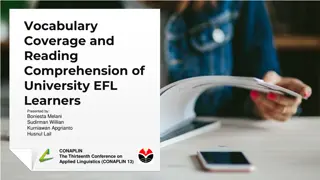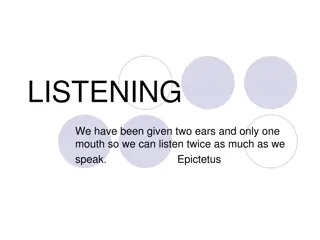GEfUS - Education Freshers Week Vocabulary for Listening
In this university student course, delve into vocabulary for listening with a focus on Education and Freshers Week. Develop connections between words and enhance comprehension through real-time listening exercises. Explore activating knowledge and building vocabulary in a structured learning environment. Engage in group discussions and activities to enhance your listening skills effectively.
Download Presentation

Please find below an Image/Link to download the presentation.
The content on the website is provided AS IS for your information and personal use only. It may not be sold, licensed, or shared on other websites without obtaining consent from the author.If you encounter any issues during the download, it is possible that the publisher has removed the file from their server.
You are allowed to download the files provided on this website for personal or commercial use, subject to the condition that they are used lawfully. All files are the property of their respective owners.
The content on the website is provided AS IS for your information and personal use only. It may not be sold, licensed, or shared on other websites without obtaining consent from the author.
E N D
Presentation Transcript
Announcements Midterm1 Grade Released Assignments: HW5 (written) Due 10/8 Tue, 10 pm HW6 (online) Will be released today, Due 10/15 Tue, 10 pm P3: Optimization expected average completion time < P2 Due 10/17 Thu, 10 pm Final exam: Thursday, Dec 12, 1-4pm, location TBD
AI: Representation and Problem Solving Integer Programming Instructors: Fei Fang & Pat Virtue Slide credits: CMU AI, http://ai.berkeley.edu
Learning Objectives Formulate a problem as a Integer (Linear) Program (IP or ILP) Write down the Linear Program (LP) relaxation of an IP Plot the graphical representation of an IP and find the optimal solution Understand the relationship between optimal solution of an IP and the optimal solution of the relaxed LP Describe and implement branch-and-bound algorithm
Linear Programming We are trying healthy by finding the optimal amount of food to purchase. We can choose the amount of stir-fry (ounce) and boba (fluid ounces). Healthy Squad Goals 2000 Calories 2500 Sugar 100 g Calcium 700 mg Food Cost Calories Sugar Calcium Stir-fry (per oz) 1 100 3 20 Boba (per fl oz) 0.5 50 4 70 What is the cheapest way to stay healthy with this menu? How much stir-fry (ounce) and boba (fluid ounces) should we buy?
Linear Programming Integer Programming We are trying healthy by finding the optimal amount of food to purchase. We can choose the amount of stir-fry (bowls) and boba (glasses). Healthy Squad Goals 2000 Calories 2500 Sugar 100 g Calcium 700 mg Food Cost Calories Sugar Calcium Stir-fry (per bowl) 1 100 3 20 Boba (per glass) 0.5 50 4 70 What is the cheapest way to stay healthy with this menu? How much stir-fry (ounce) and boba (fluid ounces) should we buy?
Problem Formulation Formulate Diet Problem with integer constraints as an optimization problem min ?1, ?2 s.t. 1 ?1+ 0.5 ?2 100 ?1+ 50 ?2 2000 100 ?1+ 50 ?2 2500 3 ?1+ 4 ?2 100 20 ?1+ 70 ?2 700 ?1,?2 Healthy Squad Goals 2000 Calories 2500 Sugar 100 g Calcium 700 mg Calories Sugar Food Cost Calcium Stir-fry (per oz) 1 100 3 20 Boba (per fl oz) 0.5 50 4 70
Linear Programming vs Integer Programming Linear objective with linear constraints, but now with additional constraint that all values in ? must be integers ??? ??? min ?. s.t. ?? ? min ?. s.t. ?? ? ? ? We could also do: Even more constrained: Binary Integer Programming (BIP) A hybrid: Mixed Integer Linear Programming (MIP or MILP) Notation Alert!
Integer Programming: Graphical Representation Just add a grid of integer points onto our LP representation ??? min ?. s.t. ?? ? ? ? min ?1, ?2 s.t. 1 ?1+ 0.5 ?2 100 ?1+ 50 ?2 2000 100 ?1+ 50 ?2 2500 3 ?1+ 4 ?2 100 20 ?1+ 70 ?2 700 ?1,?2
LP Relaxation Relax IP to LP by dropping integer constraints ??? min ?. s.t. ?? ? Remember heuristics? ? ?
Piazza Poll 1: be the optimal objective of an integer program ?. be an optimal point of an integer program ?. be the optimal objective of the relaxed LP of ?. be an optimal point of the relaxed LP of ?. Let ??? Let ??? Let ??? Let ??? Assume that ? is a minimization problem. = min ??? ??? s.t. ?. Which of the following are true? A) ??? B) ??? C) ??? ?? ? ? ? = ??? ??? ??? = min ??? ??? s.t. ?. ?? ?
Question be the optimal objective of an integer program ?. be an optimal point of an integer program ?. Let ??? Let ??? Let ?0 be a feasible point of ?. Let ?0 be the objective value of ? at ?0 Assume that ? is a minimization problem. = min ??? ??? s.t. ?. Which of the following are true? A) ??? B) ??? C) ??? ?? ? ? ? = ?0 ?0 ?0 = min ??? ??? s.t. ?. ?? ?
Question be the optimal objective of an integer program ?. be an optimal point of an integer program ?. Let ??? Let ??? Let ?0 be a feasible point of ?. Let ?0 be the objective value of ? at ?0 Assume that ? is a minimization problem. = min ??? ??? s.t. ?. Which of the following are true? A) ??? B) ??? C) ??? ?? ? Upper bound ? ? = ?0 ?0 ?0 ??? ?0 ??? = min ??? ??? s.t. ?. Lower bound ?? ?
Piazza Poll 2: True/False: It is sufficient to consider the integer points that are the closest to an optimal solution of the LP relaxation?
Solving an IP Basic Branch and Bound algorithm (essentially a search algorithm) Assuming a minimization IP =null, ??? = + 1. Build the root node, which is the original IP. Set ??? 2. Solve the relaxed LP of the node 3. If relaxed LP is feasible, get solution ??? (Update) If integer(??? (Prune) If ??? (Branch) Choose a variable ?? that has non-integer value in ??? construct two new nodes each representing a more constrained IP: New node at left branch: Add constraint ?? ????? ?? New node at right branch: Add constraint ?? ???? ?? and optimal objective value ??? ), update ??? , go to step 4 =best(??? ,??? ) and go to step 4 ??? , branch and 4. (Recursion) Pick an unexplored node and go to step 2. Stop if all nodes explored. 5. Return ??? What if it is a maximization IP?
Branch and Bound Example 15 10 5 10 15 20 25
Branch and Bound Example min ?1, ?2 s.t. 1 ?1+ 0.5 ?2 15 100 ?1+ 50 ?2 2000 100 ?1+ 50 ?2 2500 3 ?1+ 4 ?2 100 20 ?1+ 70 ?2 700 ?1,?2 10 5 Is it necessary to solve this branch? 10 15 20 25 15 15 10 10 5 5 10 15 20 25 10 15 20 25
Piazza Poll 3: When does the branch-and-bound algorithm choose not to branch the current node? (Select all that apply) A. When the LP returns an equal or worse objective value than the best feasible IP objective value you have seen before B: When you hit an integer result from the LP C: When LP is infeasible D: When the LP returns a better objective value than the best feasible IP objective value you have seen before
Solving an IP Basic Branch and Bound algorithm (essentially a search algorithm) Assuming a minimization IP =null, ??? = + 1. Build the root node, which is the original IP. Set ??? 2. Solve the relaxed LP of the node 3. If relaxed LP is feasible, get solution ??? (Update) If integer(??? (Prune) If ??? (Branch) Choose a variable ?? that has non-integer value in ??? construct two new nodes each representing a more constrained IP: New node at left branch: Add constraint ?? ????? ?? New node at right branch: Add constraint ?? ???? ?? and optimal objective value ??? ), update ??? , go to step 4 =best(??? ,??? ) and go to step 4 ??? , branch and 4. (Recursion) Pick an unexplored node and go to step 2. Stop if all nodes explored. 5. Return ??? Anything we can do to make the search more efficient?
Recall: Informed Search function BEST-FIRST-SEARCH (problem, EVAL-FN) returns a solution sequence inputs: problem, a problem EVAL-FN, an evaluation function Queuing-Fn a function that orders nodes by EVAL-FN return GENERAL-SEARCH (problem, Queuing-Fn) function GREEDY-SEARCH (problem) returns a solution or failure return BEST-FIRST-SEARCH (problem, h)
Solving an IP Basic Branch and Bound algorithm (essentially a search algorithm) Assuming a minimization IP =null, ??? = + 1. Build the root node, which is the original IP. Set ??? 2. Solve the relaxed LP of the node 3. If relaxed LP is feasible, get solution ??? (Update) If integer(??? (Prune) If ??? (Branch) Choose a variable ?? that has non-integer value in ??? construct two new nodes each representing a more constrained IP: New node at left branch: Add constraint ?? ????? ?? New node at right branch: Add constraint ?? ???? ?? and optimal objective value ??? ), update ??? , go to step 4 =best(??? ,??? ) and go to step 4 ??? , branch and 4. (Recursion) Pick an unexplored node and go to step 2. Stop if all nodes explored. 5. Return ??? What can be used as an evaluation function? Optimal value of the LP relaxation!
Piazza Poll 4: True or False: Node ? and ? are two nodes in the search tree. If (1) Node ? is not a descendent of ? (2) Node ? s LP relaxation has better optimal objective value than node ?, i.e., ??? (3)The optimal solution of LP relaxation at node ? is an integer solution, i.e., integer(??? then it is impossible that the optimal solution of the original IP is found in the subtree rooted at node ? ?< ??? ? for a minimization problem ?)
Solving an IP Improved Branch and Bound algorithm (essentially a best-first-search algorithm) Assuming a minimization IP 1. Build the root node, which is the original IP. 2. Solve the relaxed LP of the node. Return null if infeasible. 3. Given solution ??? (Update) If integer(??? (Branch) Choose a variable ?? that has non-integer value in ??? construct two new nodes each representing a more constrained IP: New node at left branch: Add constraint ?? ????? ?? New node at right branch: Add constraint ?? ???? ?? and optimal objective value ??? ), return ??? of the relaxed LP , branch and 4. (Recursion) Pick an unexplored node whose LP relaxation is feasible and has the best optimal objective value and go to step 2. Stop if all nodes explored/infeasible. 5. Return null Why still optimal? All the unexplored nodes have no better LP relaxation values!
Formulate a Problem as an IP Kidney Exchange
Formulate a Problem as an IP Kidney Exchange Given directed graph ? = (?,?), where each node represent a patient-donor pair, and an edge ?,? means donor of node ? can give one kidney to patient of node ? Find a set of disjoint cycles so as to maximize the number of nodes covered 6 2 1 4 5 3 7 8
Piazza Poll 5 Given the graph below, what is the maximum number of patients that can get a kidney through kidney exchange assuming the length of each cycle should be less than or equal to 3? A: 3 B: 6 C: 7 D: 8 6 2 1 4 5 3 7 8
Formulate a Problem as an IP Kidney Exchange Given directed graph ? = (?,?), where each node represent a patient-donor pair, and an edge ?,? means donor of node ? can give one kidney to patient of node ? Find a set of disjoint cycles so as to maximize the number of nodes covered Hint: enumerate all the cycles 6 2 1 4 5 3 7 8
Formulate a Problem as an IP Cryptarithmetic Variables: IP:























